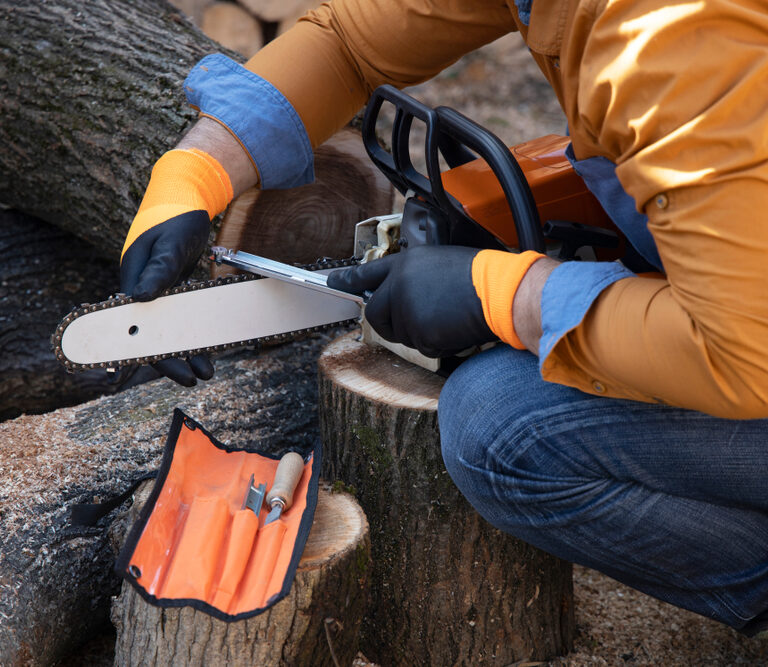Tools work best and are safest to use when they are sharp, and chainsaws are no exception. Instead of replacing the chains when they’re blunt, a simple sharpening can do wonders to restore the efficiency of your chainsaw. It only takes a few minutes before you’re ready to get back to work and will save you time and money that you might have otherwise spent searching for new chains.
Whether you prefer an electric sharpener or the old-school way of doing it manually, you’ll find the best options for your needs right here.
- Not So Clear-Cut: What’s a Good Chainsaw Sharpener?
- Top 10 Best Chainsaw Sharpeners 2023
- 1. Best Overall Chainsaw Sharpener: Stihl 2-in-1 Easy File .325”
- 2. Best Premium Chainsaw Sharpener: Oregon 410-120 Bench/Wall Mounted Grinder
- 3. Best Chainsaw Sharpener for Beginners: Pferd 17301 Sharp CS-X Chainsaw Sharpener
- 4. Most Portable Chainsaw Sharpener: Katzco Chainsaw File Kit
- 5. Best Budget Chainsaw Sharpener: Backridge Tough Chainsaw Sharpener File Kit
- 6. Best for Professionals: Oregon 520-120 Bench Mounted Grinder
- 7. Most Versatile Chainsaw Sharpener: MIZOOVA 10 Piece File Kit
- 8. Most Lightweight Bench-Mounted: Buffalo Tools ECSS Electric Sharpener
- 9. Best Electric Handheld: Oregon 575214 Sure Sharp Handheld Grinder
- 10. Most Consistent: Granberg Bar-Mount Chain Saw Sharpener
- What to Know Before Sharpening Your Chainsaw
- Cutting to the Chase
Not So Clear-Cut: What’s a Good Chainsaw Sharpener?
While several factors make up a good chainsaw sharpener, most of them depend on your requirements and preferences, as there are huge variations in what’s available. The first decision to make is whether you prefer to use electric or manual tools.
Each method has its pros and cons, and the debate between electric versus manual is a controversial topic in the tool world. Within these two camps, there are a couple of uniting factors that make a good chainsaw sharpener, as well as processes and accessories unique to each method.
Types of Chainsaw Sharpeners
Your main choice here is mostly determined by where and how you use your chainsaw, and whether you need it to be portable.
Electric Bench/Wall-Mounted Chainsaw Sharpeners
These sharpeners are best for those who are based in a workshop and use their chainsaw frequently. They are fixed to one location and need to be plugged into an electrical socket.
Most chainsaw sharpeners in this category are bench-mounted, but some, like the Oregon 410-120 can also be mounted on a wall for easy access and to be kept out of the way in the workshop, where floor space is often a valuable commodity.
In this method, the chain is removed from the chainsaw and placed into a vise. Each tooth is then sharpened using a grinding wheel, set to the required angle.
Electric Handheld Chainsaw Sharpeners
As they combine the portability of manual methods with the speed of electric sharpening, electric handheld chainsaw sharpeners are the best of both worlds. This machine looks a little like a Dremel rotary tool and uses long, thin grinding stones held at the required angle to sharpen the teeth on the chainsaw.
Electric handheld chainsaw sharpeners use a 12V battery and can be powered by your car, making them ideal for working offsite in locations where there is no electricity.
Manual Chainsaw Sharpeners
This method involves filing each tooth by hand to sharpen them. This can be done while the chain is on the chainsaw or by removing the chain and placing it in a bench vise. Even though you need to sharpen each tooth by hand, it still only takes a few minutes before you’re ready to get back to work.
Files are the most convenient and cost-effective means of sharpening your chain blades, especially if you don’t have a workshop nearby. They are generally purchased in a set like the Backridge File Kit, which includes several file sizes allowing you to sharpen a chain of any pitch.
Other Considerations
Within the category of chainsaw sharpeners you’ve chosen, you’ll also need to make sure it includes a depth gauge and is compatible with the pitch of your chain.
Depth Gauge
This is used in conjunction with a flat file to make sure that the rakers (depth gauges determining how deeply the chainsaw cuts) are the correct height relative to the teeth. Rakers that are not in the right relation to the teeth will either make your saw ineffective when cutting (the rakers are too high) or strain and overwork it (the rakers are too low).
Rakers that are too low are especially dangerous as the teeth cut too deeply into the wood at each pass, and there is a high risk of kickback. Many chainsaw sharpeners have a depth gauge built-in, but you can buy them separately if needed.
PRO-TIP: Rakers are also commonly known as depth gauges but to avoid confusion, we have used “depth gauge” to mean the tool used to maintain the rakers.
Pitch Compatibility
Chains for chainsaws come in a variety of sizes and lengths, and as such, it is important to make sure you have a sharpener that works for your specific pitch. Pitch is the measurement between three rivets on your chainsaw chain, divided by two. Manufacturers usually include it on your chainsaw or in the manual, but it can be tricky to find if you are unsure of what exactly you’re looking for. Read this guide to learn more about determining the pitch of your chainsaw.
If you simply can’t wait that long before reaping the benefits of retail therapy, you can buy a manual file kit like the Backridge File Kit that includes files compatible with all pitches. We have included a handy guide to help you find the right size file or grinding wheel to use when sharpening your chainsaw.
If you’re struggling to see the forest for the trees after all that information, we’ll help you clear some of the excess wood by pointing you to the best chainsaws on the market.
Top 10 Best Chainsaw Sharpeners 2023
1. Best Overall Chainsaw Sharpener: Stihl 2-in-1 Easy File .325”
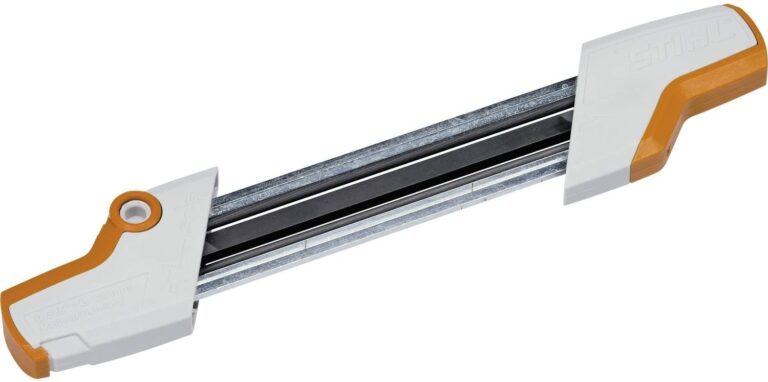
Editor’s Rating:
Quick Facts:
- Type: Manual (bar)
- Pitch: .325”
- Depth Gauge: Included
This is a super easy-to-use file that does all the hard work for you. It includes markings to help you keep the right angle, so all you need to do is line them up and give a couple of strokes to sharpen each tooth. While it might take you a little while to get used to the motion, with practice, you can sharpen the whole chain in about 5 minutes.
The whole sharpener is under 9 inches long and only weighs around 12 ounces, making it easy to take along to wherever you are working and store in the same case as your chainsaw.
Instead of single files as you find in other kits like the Backridge File Kit, this sharpener is made up of three files – two round files and one flat file. Having them arranged like this maintains the rakers as you sharpen the teeth. In all the other methods of sharpening, this needs to be done separately (see how to sharpen a chainsaw below). While this is convenient, you can do it yourself with separate files for cheaper and only a little more effort.
Stihl also offers the same file for a 3/8” (.375”) pitch.
This sharpener is a bit restrictive in that it can only be used on the .325” pitch, unlike the Backridge File Kit or the Oregon 410-120 Grinder which are more versatile.
Pros
- No set-up time
- Easy to use/good for beginners
- Portable
- Maintains rakers while sharpening teeth
- Available for 3/8” pitch
Cons
- Can only be used on one pitch
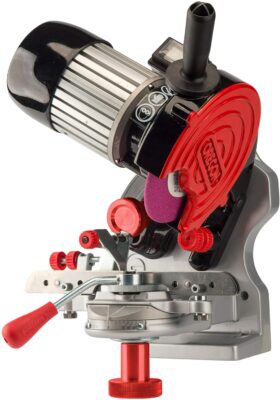
Editor’s Rating:
Quick Facts:
- Type: Electric bench/wall mounted
- Pitch: All
- Depth Gauge: Not included
This chainsaw sharpener includes three grinding wheels in various sizes to accommodate all chain pitches. There is some assembly required before you can start using this machine, and if you have never used an electric mounted chainsaw sharpener before, this can be quite confusing and time-consuming.
Once they are set up, electric mounted sharpeners consistently sharpen each tooth to the same angle, allowing the chainsaw to cut more efficiently. This is because you simply set the angle once and use that for each tooth. Inconsistent angles can make your chainsaw seem blunt as the teeth are working in opposition to each other.
If you use your chainsaw seasonally or mainly for household projects, this chainsaw sharpener is great and will fit into your workshop without taking up too much space. However, if you are a professional and/or use your chainsaw frequently (and therefore need to sharpen frequently too), the Oregon 510-120 model will better suit your needs.
This model tends to have loose ball bearings in the chain guide, which fall out easily and need to be put back. This requires a little technical knowledge of your machine to ensure it works properly.
Pros
- Best mounting versatility
- Sharpens all pitches
- Includes three grinding stones
- Consistently accurate angles
Cons
- Ball bearings in the chain guide tend to fall out
- Slight learning curve
3. Best Chainsaw Sharpener for Beginners: Pferd 17301 Sharp CS-X Chainsaw Sharpener

Editor’s Rating:
Quick Facts:
- Type: Manual (bar)
- Pitch: .325”
- Depth Gauge: Included
This chainsaw sharpener works the same way as the Stihl 2-in-1 Easy File, maintaining the rakers while sharpening the teeth. It is also comparable in size and weight (the Pferd sharpener is slightly longer but a little lighter), which is understandable as both brands are owned by the same parent company, so it is essentially the same product for a lower price.
As with the Stihl Easy File, it consists of a set of files together in one portable, easy-to-use bar. In this sharpener, however, the files can be replaced when they have worn down, instead of needing to buy a whole new bar.
It is also available for 3/8” and .404” pitches. (Editor’s note: The measurements given on the Pferd product listings indicate the size of the file that is used, not the pitch of the chain it is used on.)
Like the Stihl Easy file, it can only be used on one pitch. If you need something more versatile, the Backridge File Kit or the Oregon 410-120 Grinder are better choices.
Pros
- Easy to use/good for beginners
- Portable
- Maintains rakers while sharpening teeth
- Files available for 3/8” and .404” pitch
- Replaceable files
Cons
- Can only be used on one pitch
4. Most Portable Chainsaw Sharpener: Katzco Chainsaw File Kit
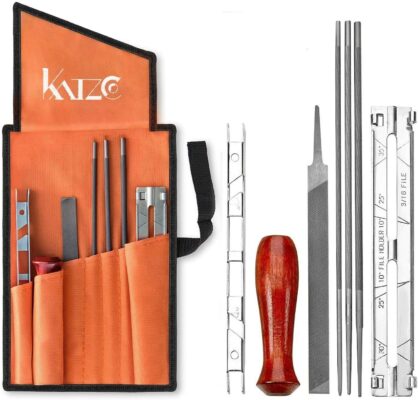
Editor’s Rating:
Quick Facts:
- Type: Manual (file kit)
- Pitch: All (.325”, 3/8”, and .404”)
- Depth Gauge: Included
This file kit works the same way as the Backridge File Kit. It also includes three sizes of round files and an angle gauge for sharpening the teeth and a flat file and depth gauge for maintaining the rakers.
The kit comes with a handy pouch to store the files and gauges for easy transportation to your work location. The variety of files means you can sharpen any chainsaw if you know which file to use; no need to spend lots of money buying multiple sharpeners or grinding wheels.
The angle gauge is of poor quality and the grips break occasionally. Also, as with the Backridge file kit, it can be difficult to keep a consistent angle when sharpening, potentially compromising the sharpness and cutting efficacy of your saw.
Pros
- Easy to use
- Portable
- Can be used on all chain pitches
- Great value for the price
Cons
- Angle guide is poor quality
- Difficult to maintain a consistent angle when sharpening
5. Best Budget Chainsaw Sharpener: Backridge Tough Chainsaw Sharpener File Kit
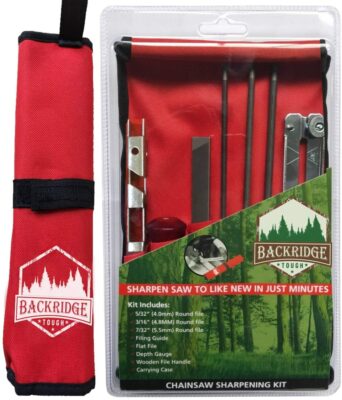
Editor’s Rating:
Quick Facts:
- Type: Manual (file kit)
- Pitch: All
- Depth Gauge: Included
File kits like this one are the original way chainsaws were sharpened when they were first invented. They are simple and easy to use once you get used to the sharpening motion and can be used on any pitch and type of chain. Files are inexpensive and easy to replace once they have worn out, leaving you more money for other tools and accessories.
This kit includes three sizes of round files and an angle gauge for sharpening the teeth, as well as a flat file and depth gauge for maintaining the rakers.
While you do need to know which size round file to use for your chainsaw’s pitch, that is as simple as reading a chart. Once you know which file you need, you can sharpen any chainsaw without needing to buy any other files or sharpeners. It does take a bit longer than using an electric bench sharpener like the Oregon 410-120 Grinder, but the time difference is only a few minutes.
As with other manual and handheld sharpeners, it can be difficult to maintain a consistent angle when sharpening, even when using an angle gauge. Inconsistent angles can compromise the sharpness of your chainsaw and you might need to get it professionally sharpened occasionally. A bar mount sharpener avoids this issue while giving you all the benefits and versatility of a file kit.
Pros
- Easy to use
- Portable
- Can be used on all chain pitches
- Good budget option
Cons
- Difficult to maintain a consistent angle when sharpening
6. Best for Professionals: Oregon 520-120 Bench Mounted Grinder
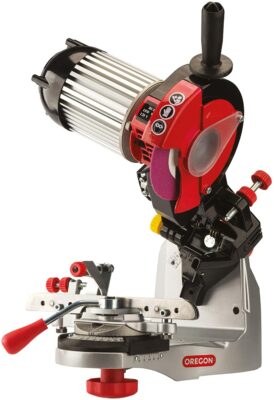
Editor’s Rating:
Quick Facts:
- Type: Electric bench mounted
- Pitch: All
- Depth Gauge: Included
The consistency of sharpening angles is the main drawcard of all electric bench mounted chainsaw sharpeners. So much so that you’ll want to sharpen your chains frequently to make your chainsaw a cut above the rest in terms of efficiency. This model has a stronger motor than the Oregon 410-120 grinder, allowing you to use it more often without wearing out your machine.
Like the Oregon 410-120, there is a bit of a learning curve to set up and operate your machine. If you are a beginner, it might be easier to go for a manual sharpening method like the Stihl 2-in-1 Easy File or a Backridge File Kit.
One drawback of this model is that the left and right sharpening angles are not even, which can stop your chainsaw from cutting well, making it seem blunt or making the cut crooked.
Pros
- Stronger motor for more frequent use
- Easy to set up
- Fast and accurate sharpening
- Raker grinder included
Cons
- Slight learning curve
- Uneven right and left sharpening angles
7. Most Versatile Chainsaw Sharpener: MIZOOVA 10 Piece File Kit
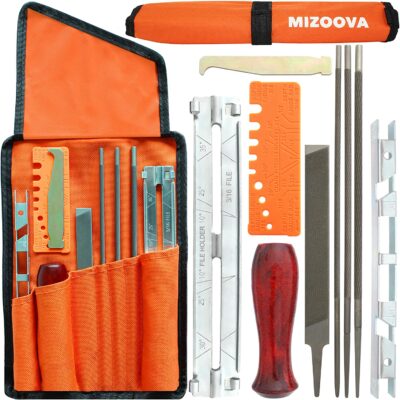
Editor’s Rating:
Quick Facts:
- Type: Manual (file kit)
- Pitch: All
- Depth Gauge: Included
This file kit, like all manual chainsaw sharpeners, is portable and versatile, allowing you to sharpen any chainsaw no matter where you are.
Like the other file kits on this list, this kit includes three round files and an angle gauge for sharpening teeth on a variety of chainsaws, as well as a flat file and depth gauge for maintaining rakers. Besides these, the kit contains a multi-tool for measuring the pitch and rakers, and a bar groove cleaner, not included with any other chainsaw sharpener.
Unfortunately, the handle and file holder of this file kit are poor quality, and while they are fine for gentle, occasional use, they won’t hold up well if you use and sharpen your chainsaw frequently. The Backridge file kit or bar mount sharpener will last longer.
Pros
- Easy to use
- Portable
- Versatile - can be used on all chain pitches
Cons
- Poor quality handle and file holder
8. Most Lightweight Bench-Mounted: Buffalo Tools ECSS Electric Sharpener
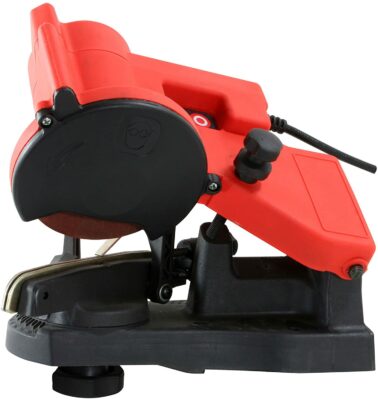
Editor’s Rating:
Quick Facts:
- Type: Electric bench mounted
- Pitch: All
- Depth Gauge: Not included
As with the other electric bench mounted chainsaw sharpeners, there is a bit of time needed to set up before you can start sharpening. Once set up, the angle is always consistent, which makes for a well-functioning chain.
This machine is a lot lighter than the Oregon 410-120 grinder and the Oregon 510-120 grinder, making it ideal for smaller workshops or if you need to be able to store it elsewhere between uses.
Unlike the Oregon electric chainsaw sharpeners, this sharpener does not have a variety of grinding wheels. Instead of changing wheels for different pitches, you need to play with the sharpening angles when working on various chains. This is more confusing than using other chainsaw sharpeners but can be learned with some practice.
It also cannot be used to maintain the rakers as you need a flat-edged grinding wheel. You’ll need to buy a separate depth gauge and flat file.
Pros
- Short time to sharpen the chain
- Works on all chain pitches
- Lightweight compared to other electric mounted grinders/sharpeners
Cons
- Does not maintain rakers
- Steep learning curve
9. Best Electric Handheld: Oregon 575214 Sure Sharp Handheld Grinder
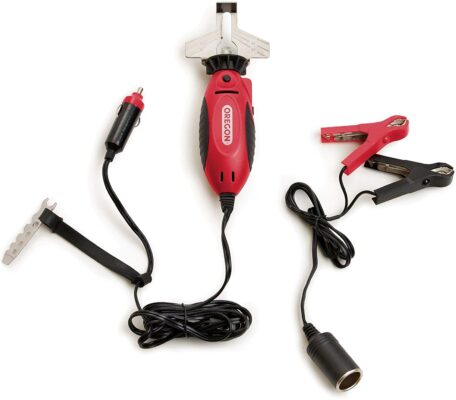
Editor’s Rating:
Quick Facts:
- Type: Electric handheld
- Pitch: All
- Depth Gauge: Not included
If you’re a fan of electric chainsaw sharpeners and need one to take into the field, this is for you. Powered by your vehicle’s battery, this handheld grinder is the best of both worlds (but in a different way to the bar mount sharpener) combining the speed of an electric grinder with the portability of manual kits.
As it is intended for use in locations outside the bounds of civilization, there is no wall socket adapter, so it’s inconvenient to use in a workshop. If you tend to do more work in a workshop, it’s probably better to have an electric bench mounted grinder like the Oregon 410-120 or use a manual chainsaw sharpener that is more versatile like the Stihl 2-in-1 Easy File or the Backridge File Kit.
This handheld grinder uses grinding stones (like grinding wheels used in electric bench-mounted models but stick-shaped like a file). These are not included and need to be bought separately. However, this means that the electric handheld grinder can be used on any pitch: 5/32”, 7/32”, and 3/16” grinding stones are all available.
PRO-TIP: these sizes are the same as the files that would need to be used and do not indicate pitch. Use this chart to see which one you need.
There is also no depth gauge or flat file included for raker maintenance; these need to be bought separately as well.
Pros
- Sharpens quickly
- Versatile - works for all pitches
- Portable
- Can use car auxiliary power outlet or car battery
Cons
- Can’t maintain rakers
- No wall socket adapter
- Grinding stones not included
10. Most Consistent: Granberg Bar-Mount Chain Saw Sharpener
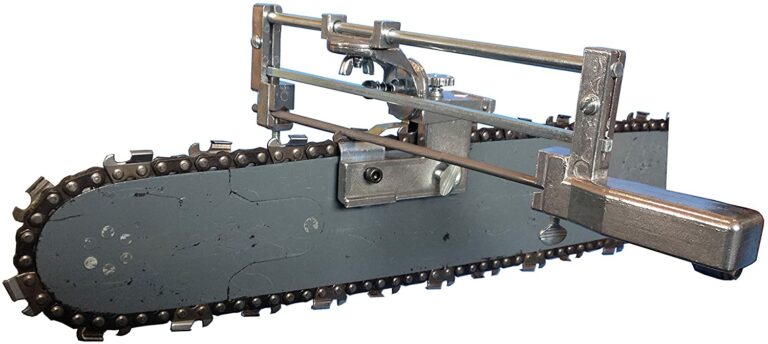
Editor’s Rating:
Quick Facts:
- Type: Manual (bar-mounted files)
- Pitch: All
- Depth Gauge: Included
This sharpener clamps onto the bar of your chainsaw, holding it steady while acting as an angle guide. The file is set in a frame that looks a little like a violin bow and fits into the bar clamp, which guides it at the right angle as you sharpen.
While there is a bit of a learning curve to set up and use this chainsaw sharpener properly, it does a great job of helping you maintain consistent angles on each tooth. Consistency is important as having the teeth aligned makes cutting easier without straining the chain or motor of your chainsaw.
The ability to change out the files means you can use this sharpener on any chainsaw, provided you have the right file. A major con is that the files are not included with this sharpener (and they’re the part that sharpens the teeth). However, files are inexpensive to buy separately and come in packs. Alternatively, you could pair this with a Backridge File Kit for extra versatility.
Pros
- More consistent than other manual sharpening methods
- Portable
- Works for any pitch
Cons
- Files not included
- Slight learning curve
- Takes time to set up properly
What to Know Before Sharpening Your Chainsaw
Electric versus manual is a common debate in the tool world. No matter whether you’re a hand- or power tool woodworker, the main thing we are concerned here with is how well the chainsaw sharpener works (we are all just here to sharpen our chainsaws after all), and how to use it safely.
Cutthroat Competition: Electric vs. Manual Chainsaw Sharpeners
The electric versus manual tool debate has been going on since electric tools were developed and will probably continue for many decades to come as each method has its pros and cons. For the most part, it boils down to your personal preference.
Electric Wall/Bench-Mounted Chainsaw Sharpeners
As they are fixed to a bench or wall, these electric chainsaw sharpeners are very steady and, therefore, very accurately and consistently sharpen your chainsaw teeth to the correct angle. This is important because uneven teeth don’t cut smoothly, straining the motor of your chainsaw and raising the risk of kickback.
Although they do have a bit of a learning curve, once they are set up you don’t need to put in much effort to quickly sharpen and get back to using your chainsaw. On the other hand, you need to remove the chain from the chainsaw to sharpen it, which is not necessary with manual methods, so the time taken to sharpen your chainsaw ends up roughly the same.
Electric Handheld Chainsaw Sharpeners
While you still get a fast sharpening for your chain blades, the portable nature of these chainsaw sharpeners can compromise the accuracy of the sharpening angle. They’re more difficult to control and it’s hard to maintain a consistent angle. With this in mind, electric handheld chainsaw sharpeners are better for more experienced users and/or those who are confident in their fine-motor skills. If you are a beginner, a manual chainsaw sharpener like the Stihl 2-in-1 Easy File or the Backridge File Kit might be a better option.
Two cons of electric chainsaw sharpeners and/or grinders are the risk of over-sharpening the teeth, wearing them down quickly, and over-heating the teeth, making them brittle and more prone to being damaged. However, as the chain generally needs to be replaced after being sharpened 2-4 times, this isn’t a big deal for most people.
Manual Files
Although they take a bit of practice, manual chainsaw sharpeners are easy to use and don’t have much of a learning curve, making them great for beginners, especially if you don’t want to make a big financial investment. They are also ideal for work in remote locations as they fit easily into your back pocket and don’t need electricity or a battery to operate. There’s also no risk of over-sharpening as there is with electrical chainsaw sharpeners.
A major downside to manual and electrical handheld sharpeners is that it can be tricky to maintain a consistent angle when sharpening, requiring the use of an angle gauge or a bar mount sharpener.
To Sum Up:
| Electric | Manual | |
| Cost | Expensive (usually over $200) | Inexpensive (usually under $40) |
| Consistency of sharpening angles | Bench/wall-mounted – very consistent
Handheld – Same as a manual file |
Depends on the person sharpening, but not very consistent unless you’re using a bar mount to guide the files |
| Learning curve | Fairly steep as you need to learn how to set up the various parts to the right angles and depths | Very little, other than to practice maintaining the correct angle and pressure. |
| Set-up time | 5-10 minutes to set stops and grinding wheels at the correct angle (longer for initial set up) | 2 minutes |
| Sharpening time | Between 5-30 minutes depending on how practiced you are | Between 10-30 minutes depending on how practiced you are |
| Portability/use in remote locations | Not portable (except handheld sharpener) – very heavy and needs a close power source | Excellent. Tools are small and light, don’t require a power source |
| Other | High sharpening speed increases the risk of over-grinding and overheating the teeth | Some practice required |
Preparing to Sharpen
Before you can get stuck into sharpening your chainsaw, there are a few things you should know that will help you do it safely and efficiently.
Advice About a Vise
A vise helps steady your chainsaw for better accuracy and safety as you sharpen. Manual and electric handheld sharpeners need to be used with a bench vise or stump vise (which has small spikes that are driven into a stump or log), purchased separately from the sharpener. Bench-mounted sharpeners come with their own vise.
Bench vises and electric bench-mounted sharpener vises are used to hold the chain that has been removed from the chainsaw. Stump vises support the bar with the chain still attached.
Pitch Perfect: Choosing the Right File for Your Chain
Pitches aren’t just for baseball. Each type of chainsaw chain has a unique structure and link size that needs a specific file or grinding wheel to fit the profile of its teeth. Only the right size sharpening tool can maintain the correct angle and shape of each tooth.
The pitch can be found by measuring the distance between three rivets and dividing it by two. You can also usually find it on your chainsaw or in your user manual.
This chart shows which sharpeners are best for the corresponding pitch:
| Pitch | File | Grinding wheel (Thickness) |
| 3/8” low profile
.325” |
5/32” (4mm) | 1/8” |
| 3/8” | 3/16” (4.8mm) | 3/16” |
| .404” | 7/32” (5.5mm) | 3/16” |
Mr. Right (Angle)
And by right angle, we mean the correct angle, which is actually an acute angle. Most chainsaws are used for crosscutting and are sharpened at a 30° or 35° angle, which you can either set on your bench grinder or find using an angle gauge when using files or an electric handheld chainsaw sharpener. For a rip cut (used for milling on an Alaskan sawmill or similar set-up), the chain is sharpened at an angle of about 10°.
Safety Equipment
Apart from a vise to hold your chainsaw or chain steady, it’s also a good idea to use safety goggles and gloves to protect your eyes and hands.
How to Safely Sharpen a Chainsaw
Once you have got the correct files and safety equipment, set up your chainsaw in the vise, or remove the chain to secure it in the bench vise. Make sure you switch off the chainsaw before removing the chain or sharpening the chain on the bar.
- Identify the shortest or most damaged link. This is where you’ll start and will be the template for all the other teeth. You can measure the teeth with calipers or a small adjustable wrench.
- Once you’ve sharpened it, mark this first tooth with a marker. Some chains have one tooth already marked, so if you don’t have one particularly short or damaged tooth, you can start here. You can tell the tooth is sharp when the edge changes from a dull grey to a bright, shiny silver color.
- File or grind all the teeth going in the same direction as the one you just sharpened. This will help you maintain a consistent angle if you are sharpening manually. Once those are finished, repeat with all the teeth facing the other direction.
- When you have sharpened all the teeth, check and file the rakers if needed. A depth gauge will ensure you keep them at the right height relative to the teeth. If the top of the raker pokes through the depth gauge, file it with a flat file until it is flush with the gauge.
- Lastly, give your chain a good clean and oiling. You can even soak your chain in lubricant until its next use. This helps to avoid overheating your chain while cutting and prevents rust from forming which can quickly deteriorate and damage your chain.
For more specific instructions, watch these videos on how to sharpen using manual or electric bench-mounted sharpeners.
How Often Do I Need to Sharpen My Chainsaw?
It depends who you ask but a good rule of thumb is once for every tank of gas or around five hours of use. While this is good for general maintenance, you will need to sharpen your chain if it is noticeably dull, or if you hit rocks, sand, nails, or ice, all of which can damage the teeth and potentially cause kickback.
If your chain is very damaged, you’ll have your work cut out for you filing it down by hand. In this case, it’s better to use an electric grinder (if you have one) or take it for a professional grinding.
How Many Times Can I Sharpen Before I Need a New Chain?
Some say 3-5; others say up to 12 times. It all depends on the method you use to sharpen your chainsaw; electric grinders will take off more material than files, and if some teeth are damaged, you will need to take off more material to fix it and even up all the other teeth to match. To give a bit more direction, there is usually a line on the top of each tooth (about 1/8”), which is the minimum amount of metal that the tooth needs to be able to cut. Once you’ve reached that line, it’s time for a new chain.
Troubleshooting a Chainsaw That Won’t Cut
It shouldn’t take much effort to cut with your chainsaw. You should be able to lightly rest your chainsaw onto the wood you want to cut and have the weight of the saw do all the work for you.
If you need to apply pressure or use a sawing motion to get through the wood, stop. Something is not working well on your chainsaw and it is dangerous to carry on as you could experience kickback. The issue is not always a blunt chain.
Here are some common issues to look out for if your chainsaw isn’t cutting well:
Blunt Chain
A sharp chainsaw produces chips rather than sawdust. If you see sawdust or the wood starts smoking, your chainsaw probably needs to be sharpened. You should sharpen your chainsaw at least once every tank of gas, or after you hit rocks/nails as this damages and blunts the teeth.
High Rakers (Depth Gauges)
Rakers (also called depth gauges) control how deeply your chainsaw cuts into the wood. If they haven’t been maintained in conjunction with your sharpening, they might be a bit high and prevent you from cutting into the wood. Use a depth gauge and a flat file to adjust them as needed.
Loose/Backward Chain
Another common issue with a chain that won’t cut is if the chain is too loose or put on backward. The chain should be able to move easily along the bar but not hang off it. You can tighten/loosen the tension by turning the adjustment screw.
The teeth of your chain should have the sharp edge moving from the top of the chainsaw toward the end of the bar. If your chain is on backward, you’ll probably see smoking or burning wood and hear a disproportionate chain rattle.
Of course, if all else fails, you may need to buy a new chainsaw. But this should only be considered once you’ve exhausted all other options; a new sharpener is much more cost-effective.
Cutting to the Chase
Just as there are many types of chainsaw and chains for different purposes, there is a variety of sharpening methods. Whether you prefer using manual files or an electric chainsaw sharpener, there’s something here to fit your needs and budget.
No matter your choice, they all have the same end goal: saving you time and money (and possibly a limb) by sharpening your chain instead of having it professionally sharpened or buying a new one.
